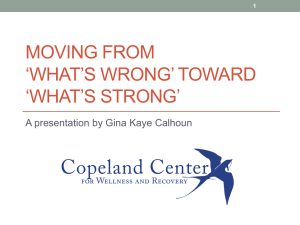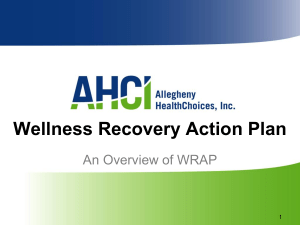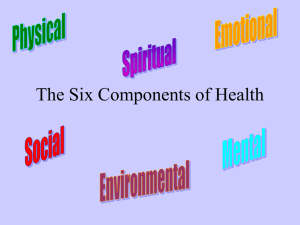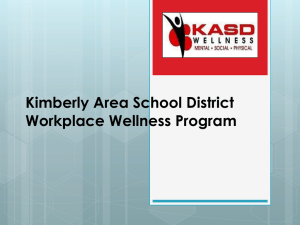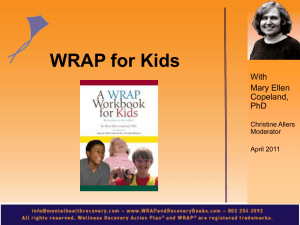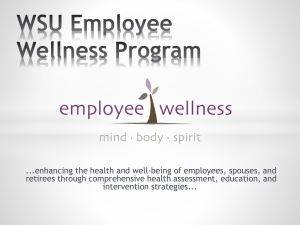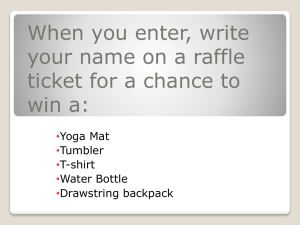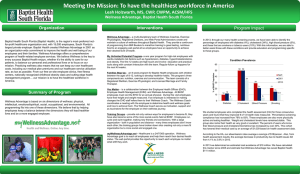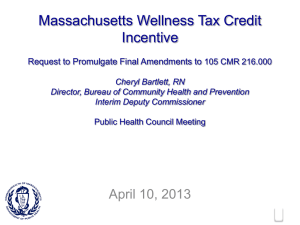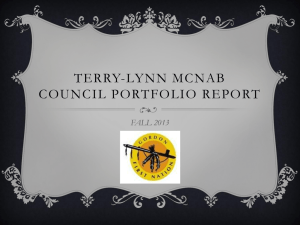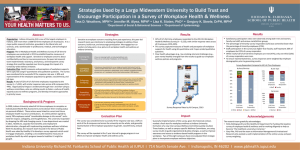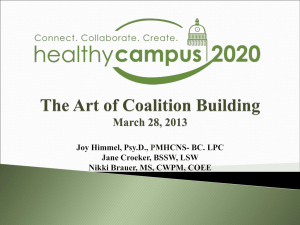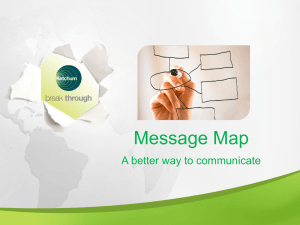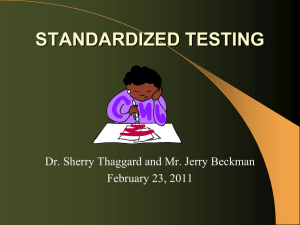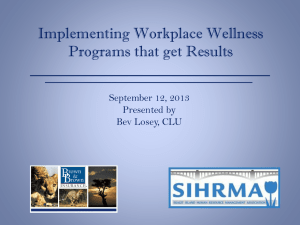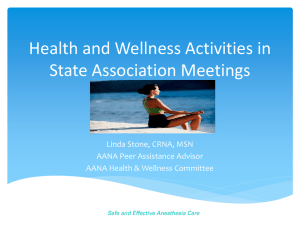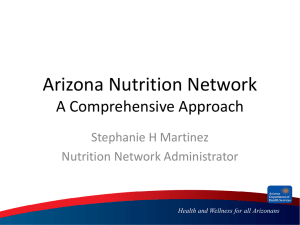Wellness Recovery Action Plan: Overview
advertisement
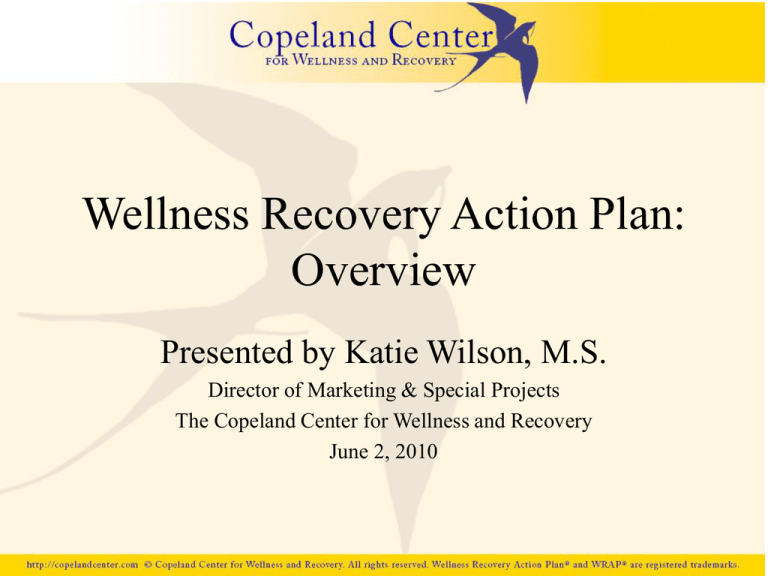
Wellness Recovery Action Plan: Overview Presented by Katie Wilson, M.S. Director of Marketing & Special Projects The Copeland Center for Wellness and Recovery June 2, 2010 Key Concepts • • • • • Hope Personal Responsibility Education Self-Advocacy Support There is Much to Hope For! • You can get well and stay well for long periods of time! • You can work toward and meet your goals • You don’t need nor will you benefit from dire predictions about the future Personal Responsibility • You are the expert on yourself. • You know what you want and need. • It is up to you to take personal responsibility for your own wellness and your own life. Education • Learn all you can about yourself so that you can make good decisions about: – – – – – – – Treatment Lifestyle Career Relationships Living Space Leisure Activities All Aspects of Your Life Self Advocacy • Go for it with courage, persistence, and determination; • Express yourself clearly and calmly until you get what you need for yourself Support • Support from family, friends, and care providers is definitely helpful. Being effectively supported will help you feel better and enrich your life. • You will benefit from having at least 5 good friends or supporters you can call on when you want or need . . . . WRAP • Will help you stay as well as possible • Help you keep track of difficult feelings and behaviors and develop plans of action to help you feel better • Tell others what to do for you when you feel so badly you can’t make decisions, take care of yourself, and keep yourself safe WRAP You and only you decide: • If you want to write a WRAP • How much time it takes you • Who you want, if anyone, to help you with it • How you use it • Who you show it to • Where you keep it WRAP To develop your own Wellness Recovery Action Plan begin by developing a list of personal WELLNESS TOOLS Wellness Tools • Wellness tools are things you do to keep yourself well, and the things you do to help yourself feel better when you are not feeling well. Wellness Tools • You may have discovered them yourself or learned about them from others. • Most of them are simple, safe, free and noninvasive. Wellness Tools • • • • • • • • Exercise Light Relaxation Techniques Peer counseling Journaling Video Chatting with friends Eating a healthy meal Anything you enjoy Daily Maintenance List Write down how you feel when you feel well. Daily Maintenance List Some words that others have used: Bright Outgoing Humorous Athletic Content Reasonable Happy Optimistic Competent Industries Responsible Withdrawn Daily Maintenance List You may also want to include on this page any specific things you want to work in your WRAP like: • Building Your Self-Esteem • Going Back to Work • Getting a Different Jobs • Any goal you want to work on Daily Maintenance List Make a list of things you need to do for yourself every day to keep feeling well Daily Maintenance List Be specific: • Get up at 7am on weekdays so I can get to work on time • Go for a walk • Write in a journal • Spend half an hour enjoying a fun, affirming creative activity • Drink 5 glasses of water Daily Maintenance List • Next make a reminder list for things you might choose or need to do any day. • Reading through this list daily and doing those things that need to be done reduces stress in your life and helps keep you on track Daily Maintenance List • Ideas of things that might be included on this list are: • Calling your counselor • Being in touch with family • Doing the laundry • Paying bills • Taking a hot bubble bath Triggers • External events or circumstances may make you feel like you are getting ill. • These are normal reactions to life events but if you don’t respond to them, they may actually make you feel worse. Triggers Examples: • Problems at work • Financial problems - a big bill • Feeling left out • Anniversary of a loss or trauma • People shouting • Having to talk to someone I don’t know Triggers Action Plan • After your list of Triggers, develop a plan that you feel will keep you from feeling worse if a triggering event occurs. Triggers Action Plan Sample Plan: • Get one thing done that I know I can do well • Talk to a supporter • Play my guitar for an hour • Do a breathing exercise • Make sure I do everything on my daily maintenance list Early Warning Signs Early Warning Signs are internal and may be unrelated to reactions to stressful situations. They are subtle signs of change that indicate you may need to take some further action. Early Warning Signs Examples: • Forgetfulness • Being impatient • Spending money impulsively • Feelings of hopelessness • Thinking something bad is going to happen Early Warning Signs Action Plan Sample Plan • Spend at least 1 hour involved in an activity I enjoy • Get plenty of rest • Tell a support how I am feeling • Distract my mind from anxious thoughts • Drink some water When Things are Breaking Down or Getting Worse You may begin to feel even worse - very uncomfortable - but you are still able to take some action on your own behalf. This is a very important time. It is a necessary to take immediate assertive action to prevent a crisis. When Things are Breaking Down Examples: • Unable to sleep • Obsessed with negative thoughts • Avoiding Eating • Feeling oversensitive or very fragile • Risk taking behaviors like fast driving When Things are Breaking Down Action Plan The plan needs to be clear and directive, with many things you must do and fewer choices Sample: • Arrange for at least 3 days off of work • Call my doctor or care provider and ask for their advice • Do 2 peer counseling sessions, 3 deep breathing exercises, 2 focusing exercises Crisis Planning It includes: • What you are like when you are well • Indicators that others need to “take over” • Who “takes over” and who doesn’t • Information on your healthcare providers and medications Crisis Planning • Home/Community/Respite Plan • Acceptable and Unacceptable Hospital Facilities • Things others can do to help • Things that others might do that would make you feel worse Crisis Planning • A list of chores and tasks for others • Indicators that the plan is no longer needed • Signatures of key people Post Crisis Planning • The time you are healing from a crisis can be very important • Although you may feel ready to begin taking care of yourself again, you may still be dealing with difficult feelings or symptoms, as well as the aftermath of the crisis Post Crisis Planning • Address Issues and Create a Timetable for resuming responsibilities • Proactively make decisions about the following issues that make sense to you Post Crisis Planning • How would you like to feel when you have recovered from the crisis? • Who do you want to support you through this time? • Where will you go afterward? • Who would you like to stay with you? Post Crisis Planning List: • Things you can ask others to do for you • Things the can wait until you feel better • Things you need to everyday • Things and people you might need to avoid • People you need to thank or apologize to • Signs you can return to your daily maintenance list WRAP • Perhaps you have started to work on your own plan or are helping someone else develop their plan. • If so, give yourself some credit for the work you are doing. You nay even want to give yourself a reward from time to time. The Copeland Center Offering WRAP Facilitator Training • August 16-20 - Chicago, IL in connection with NAOPS conference • September 20-24 - Brattleboro, VT Books & Resources Books by Mary Ellen Copeland are available on: mentalhealthrecovery.com Book Special! The WRAP Story On sale now! $14.95 (reg. $19.95) mentalhealthrecovery.com Wellness Retreat Experienced Advanced Level WRAP Facilitators will be leading a wellness retreat in southern New Hampshire in October 2010. • • • • For more information, visit: http://copelandcenter.com Mentalhealthrecovery.com Mentalhealthrecovery.com/webinars.php
